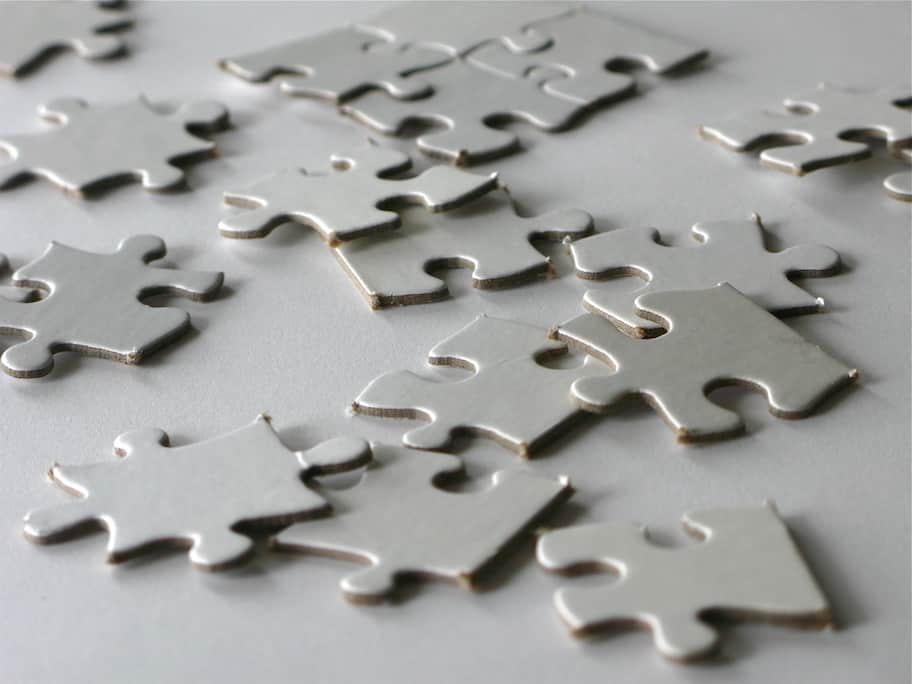Last Updated on February 23, 2024 by JigsawPuzzleGuru

When you read the title of this article, what was your first thought? If we were guessing, we’d say that the majority of readers are puzzled at the idea of there being more than one type of jigsaw puzzle. Isn’t it just an image that has been divided up into a frustrating number of smaller pieces that we have spent a lifetime putting back together? Well, that’s one way of looking at it, but it’s not the right way. There are actually many types of jigsaw puzzles!
In today’s article, we are diving deep into the world of jigsaw puzzles to discover the diverse range of puzzle types that you can do.
Don’t forget to explore the images below to learn more about these types of jigsaw puzzles!
Table of Contents
Type 1: Flat 2D Jigsaw Puzzles
This first category covers the majority of jigsaw puzzles and even contains some of the categories that we mention further below in this list. A flat, two-dimensional puzzle is the most common type of jigsaw and is also the one people most commonly think of when a jigsaw puzzle is mentioned.
The image on the jigsaw is much harder to categorize since there are so many. Virtually any image can be turned into a flat 2D jigsaw puzzle. The more intricate the picture, the more of a challenge it represents because it becomes harder to identify high-contrast areas and color zones to group the pieces together.
Type 2: “Repetitive Design” Jigsaw
These are a huge step up from the more traditional flat 2D jigsaw puzzles that we described above. In a repetitive design jigsaw, you typically have an image in which you have either the same object repeated over and over in an identical fashion or perhaps even just a block of color for which you have to rely entirely on your ability to find the right shapes and not to identify features based on colors and contrast.
What these types of jigsaw do is remove your ability to rely on more tried-and-tested strategies to solve jigsaw puzzles. In our previous article on jigsaw puzzle-solving strategies, we described, for example, the strategy of locating contrasting features or color zones of the image and then grouping those pieces so you can have a better chance of quickly finding pieces that fit together. With a repetitive design or a block-color design, you don’t have these advantages. The only thing you can do is build the edge and then keep working inwards by identifying the right shapes.
Repetitive design jigsaws are not for the faint of heart!
Type 3: 3D Jigsaw Puzzles
Why not throw in an entirely new dimension to your jigsaw puzzling (literally) and attempt one of these 3D jigsaw puzzles. Upon completion of a 3D puzzle, the result will typically be some kind of three-dimensional model. The most common subjects of a 3D jigsaw puzzle are buildings, especially famous buildings. You might get jigsaws of famous landmarks, for example, like the US Capitol, the Palace of Westminster, or Notre Dame Cathedral, to name but a few.
Many popular TV shows have created 3D jigsaw puzzles of their iconic fictional locations. A great example is the hit fantasy show Game of Thrones, which released several great 3D sculptures, including a puzzle of the fictional capital of Westeros, King’s Landing. Adding the dimension of depth and form to the puzzle makes it challenging in a whole different way and offers veteran jigsaw enthusiasts an entirely new challenge to sink their teeth into.
Type 4: Murder Mystery Puzzles
This is more of a niche category, but certainly interesting and unique enough for its mention in our list. A murder mystery jigsaw is typically not one puzzle, but two. You need to put together both jigsaws without the help of a picture, which is the first level of challenge that you face.
Upon completing the puzzles, you then take out the accompanying booklet or other reading material and use evidence that you should be able to identify from the jigsaw puzzles to solve the murder mystery. For families whose members all have differing tastes in hobbies, this is a great way to bring everyone together in a single activity.
The puzzle enthusiasts can first shine as they lead the way in assembling the jigsaws, but then those who are more driven by deduction and lateral thinking can have their turn in leading the efforts to solve the murder mystery.
Type 5: WASGIJ
You might be looking at this word in utter bafflement, but let us explain. Some of you will have quickly noticed that WASGIJ is “JIGSAW” written backward. This unique jigsaw concept was created by British game maker, Jumbo Games. It dates back to 1997 but has taken many years to take off and reach its current level of popularity.
Jumbo Games describes WAGIJ as being made up of six different concepts, but with one underlying theme: the image that you see on the box is not the one that you’ll be making when you finish the puzzle. The six concepts are as follows:
- Original WASGIJ– the solvers have to use their imagination and some provided clues to create the puzzle image from the perspective of someone that appears in the original image on the box.
- Destiny WASGIJ– the puzzlers solve a “time travel” concept where they have to use their imagination to create an image of what they think the image shown on the box looks like in the modern-day.
- Mystery WASGIJ– the puzzlers put together a jigsaw that figures out what will happen to the characters on the box in the next few minutes.
- Christmas WASGIJ– puzzlers piece together an image of what the characters on the box image are looking at.
- Imagine WASGIJ– puzzlers put together an image of what the characters in the box image will look like if imagination turned into reality.
- Back to…WASGIJ – another time travel concept in which puzzlers have to take the modern image on the box and reimagine what it would be like in years past.
Type 6: Mega Jigsaw Puzzles
This type of puzzle is for those who have very big empty tables and lots of extra time on their hands. Where a common jigsaw puzzle might range from 500 to 3000 pieces or so, the “mega” category of puzzle takes the number of pieces into the stratosphere. How do you fancy trying to solve a jigsaw of 10,000 pieces, or how about 20,000 pieces. That’s what you’re contending with when you attempt one of the mega jigsaw puzzles.
The key to these puzzles is perseverance, patience, and the employment of all the skills and experience you have accumulated in years of finishing jigsaw puzzles in the past. The principles don’t change, but the sheer amount of work involved certainly does.
Type 7: Floor Jigsaws
A “floor jigsaw” is a puzzle designed especially for young children. It will typically be made up of larger, more colorful, and vivid pieces, perhaps ranging from 20 to 100 at the most. The child can discover their love of jigsaws, as well as begin to build key cognitive skills by completing these jigsaw puzzles.
Type 8: Hand-cut Wooden Jigsaws
Finally, we come to a kind of “retro” jigsaw style that is finding a new fanbase in the modern world. After the invention of the laser cutter, jigsaw making became a lot faster and more viable. Almost any image could be cut into a jigsaw very quickly, and no longer did we have to rely on a small army of skilled artisans to painstakingly cut each piece by hand.
That older style of a hand-cut wooden jigsaw, however, now has its own niche category. While it used to be the mainstream, it was overtaken by technology, which is great for most of us because it means there are more types of jigsaw puzzles than ever for us to enjoy. For those wanting something with a little more old-world charm, however, the hand-cut wooden artisanal jigsaw is a type they can explore.
Conclusions: Whatever the Type, the Fun and Benefits Don’t Change
Regardless of the type of jigsaw that you and your family choose to enjoy, the many benefits and fun factor will always be there. Jigsaws are great for kids’ cognitive development, but also are just a fantastic way for the family to come together and spend quality time doing something constructive and creative. Whichever style of puzzle you go for, these facts don’t change. Enjoy your jigsaw puzzle time, and try as many different styles as you can.
What types of jigsaw puzzles are your favorite?
Check out 7 Tips for Solving Jigsaw Puzzles next.
Read more jigsaw articles HERE!
